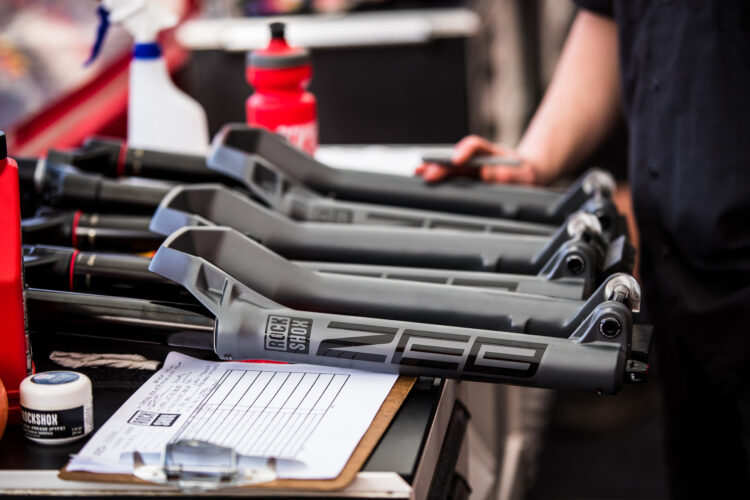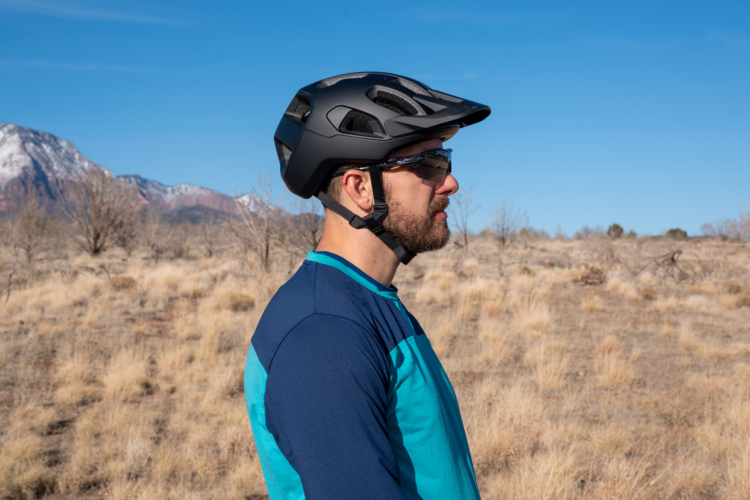
Why not just make a single-crown gravity fork using existing 40mm stanchions? Since they had the tubes around, there is a good chance the Fox engineers tried that while developing this latest model. After oodles of testing and rumors had rumbled, they released this new 38 fork in April of 2020. It now comes stock on a number of bikes with 160 to 180mm of travel, and we wanted to take a look at why some riders may want to try the stiffer stanchions.


The 36 and 38 have most of all of the same sweet chassis features and functionality, from the burp-valves that release air pressure in the lowers after drastic elevation gain, to the floating axle that allows the stanchions to telescope with less friction and the oil bypass channels that are designed to move a little more lube near the seals. These forks are well thought out from axle to crown.


In addition to the broader stanchions on the 38, the fork’s internal steerer tube is ovalized with additional material on the front and rear for increased stiffness. By their measurements, Fox says that the 38 fork is “31% stiffer transverse shear, 17% stiffer fore/aft, and 38% torsionally stiffer than the 36.” All that material does make the fork a fair bit heavier, tipping the scale roughly 300g deeper than the Fox 36 that we tested last season.

Is that additional weight worth it?
There’s no denying that this fork feels more precise on track. When you’re trying to squeeze milliseconds out of a few turns on a rough ribbon of dirt, the Fox 38 will follow your preferred line a bit better than the 36, allowing you to ride a touch faster and shave time. Weighing 69kg in full kit, the stiffness difference between the two forks is likely less noticeable for me than someone who weighs more or rides harder and faster. Fortunately there are scads of riders with more skills and courage than I, and for those folks the 38 might be a game changer.
For example, Jesse Melamed and I are roughly the same size humans, but he rides about 3X faster than I do and has more upper body muscle. Melamed chose the 38 over the 36 for its feel and fastness this season, and it hasn’t done hime wrong. For athletes who are aiming at the finish line with hopes of a podium, the weight penalty is likely worth it.
Let’s not convert that thinner fork into a DIY lampshade just yet. Folks who weigh a little less, like Orbea’s Laura Charles, are still having great success racing on the 36 forks. In fact, there’s a large number of athletes in the elite women’s and men’s fields who race on the Fox 36 or the equivalent RockShox Lyric. Party bikes are heavy these days, no matter what material the wheels and frame are made of, which is great because we get to break fewer frames and plug fewer punctures. However, If there is a way to shave a little weight from those steeds that doesn’t significantly affect performance, why not drop some grams? For many lighter-weight riders, and folks who ride with less front-end pressure, the 36 remains a good option.
Also, we have to get to the top of those descents. If you’re not hunting for the lunch-lap QOM, or racing gravity events, there’s a good chance that the 36, Lyric, Helm, or similar fork is plenty stiff. These newly lighter forks will burn fewer cookies on the climb, leaving a little more fuel for the fun part. If you enjoy all day adventures on your gravity bike, those cookies will add up along the way.

The split between the 36 and 38 isn’t just stiffness and weight. The setup process also varies, and I found the 38 to be a bit more finicky to dial in. I started with the recommended Fox setup all around, including air pressure, volume spacers, compression, and rebound clicks. I pumped in the max recommended pressure for my weight category. It didn’t feel great. As with most stock setup guides, the first half of the travel was far too soft, lacking both support and feedback. I tried adding high and low speed compression, and speeding up the rebound a few clicks at a time, and as usual the better answer was in the air spring.
If you reach this point, it can help to forget about the static-sag measurement, and set up your suspension to feel the way you want it to first. You can make small adjustments later to find the balance between ride feel and the amount of travel that’s left above the fun ring at the end of descents. After all, it doesn’t matter whether you use full travel or not if you’re blowing through the first half of it without adequate support. The next time you’re at an elite gravity race, look at the fun ring on the pro riders’ forks as they gasp and wheeze past the finish line. That ring will very rarely be resting against the fork crown.

To dial the Fox 38 in, I added air pressure by a few PSI at a time, adjusting the rebound and compression along the way. As the fork neared a happy feeling of support I noticed that I was only using about 130 of the 170mm on really rough tracks. The next move was to remove one of the volume spacers, and readjust the air pressure to find similar support with less progressivity. The “nailed it” spot I arrived at is more that 15 PSI above the maximum pressure that’s recommended for my weight bracket, with a good amount of high speed compression and a few clicks of low speed. Like the 36, the rebound knobs were fairly simple to set, and I regularly adjust them by a click or two depending on terrain. Unlike the 36, “quick and simple” are not adjectives that relate to my experience with the 38 setup, but once all of the strings are in tune it plays beautifully.

With the right tune, the 38 offers abundant support over successive impacts, and there is broad enough adjustment for a wide variety of riding styles and preferences. The fork’s fluid initial stroke maintains grip just as well as the 36 did, despite the stiffer chassis, and the added rigidity allows the rider to lean forward on that front tire traction as much as their arm strength will allow.
Pros and the cons of the Fox 38 mountain bike fork
Pros
- More precise steering
- Stiffer throughout
- The rougher, the better
Cons
- Heavier
- Longer setup period
- Limited advantage for lightweight riders
Final Thoughts
One of my favorite things about mountain biking is that there is always something to learn and improve, no matter how fast or fancy you might ride. For that reason alone, I find the new Fox 38 a worthwhile upgrade. It allows for more precise steering and faster lines through the messiest stone piles, and I’m forever intrigued by riding faster. Regardless of your relationship with racing, if speed = fun this fork might be worth a squish. I look forward to seeing what other companies develop in this space. Fingers crossed that things become lighter from here.
- Price: from $849
- Buy from Backcountry and other online retailers





















3 Comments
Feb 14, 2022
Nov 3, 2021
FWIW, Rallon going to significantly more bike as my current rig is running a Fox 34. I've done multiple demo rides on the Fox 36 which for test rides I get them setup good - but never great. Best fork I've ridden is an EXT Era, but I don't think I can convince the shop to swap that in ;-)
Jul 30, 2021